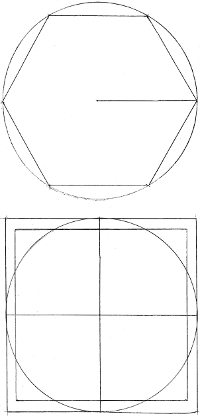Chapters
- 1. Height and weight
- 2. Uses of the SI
- 3. Numbers and letters
- 4. Plain geometry
- 5. Circles
- 6. Compound interest
- 7. Population growth
- 8. Solid geometry
- 9. Molecules
- 10. Radioactive decay
- 11. Pressures
- 12. Gene frequency
- 13. Energy
- 14. Summary
Sections
Radius, Circumference, and Pi
The radius (r) of a circle is the distance set on your compass when you draw a circle, and the distance from the center to the boundary of any circular object. The distance around, or perimeter, is called the circumference (C), and the straight-line distance across the circle, through the center, is called the diameter. The diameter (d) is exactly twice the radius. There is a fixed ratio between the circumference (C) and the diameter (d), expressed algebraically as C⁄d. What, exactly, is the value of this ratio?

The number must be less than 4, because the perimeter of a square that encloses a circle is 4d. See Figure 5-1. The number must be greater than 3, because when 6 radii are marked off on the circumference, the straight-line figure inside is a regular hexagon, with perimeter 3d.
Archimedes of Syracuse (Sicily, not New York) was curious about the precise ratio between C and d. Around 250 BC, he had no calculator and not even a good number system, but by constructing polygons with more-and-more sides, and dividing them into triangles, he found a good approximation of the number, which about 1700 AD came to be called pi (π) the 16th letter of the Greek alphabet.
C⁄d = π, C = πd = 2πr
31⁄7 = 22⁄7 > π > 3 10⁄71 = 223⁄71
The ratio of circumference to diameter of a circle (π) is given here as approximately 31⁄7, which is the same as 22⁄7. It is possible to have fractions between any two whole numbers, not just between 0 and 1. In principle, the interval between 3 and 4 could be divided in 71 equal pieces, and we could take 10 of them to make the desired ratio. Thus π is also about 310⁄71.
Although fractions can be precise, and operations with fractions have simple, well-defined rules, it is often more practical to do calculations with their decimal equivalents: 1⁄4 = 0.25, 1⁄8 = 0.125, 1⁄16 = 0.0625 etc. The decimal equivalent of a fraction is the upper number (numerator) divided by the lower one (denominator).
Exercise 5-1. Find the decimal equivalents of the Archimedes fractions.
An average of these two values is very close to the desired ratio. A closer ratio, 355⁄113, was known to ancient Chinese astronomers. The value in a scientific calculator is 3.141592654. By playing with numbers, one can find fractions even closer, such as 12 546 274⁄3 993 603.
The value of π can be calculated ever more closely by adding various series of ever-smaller fractions (discovered by Leibniz and Euler), a tedious procedure ideally suited to computers. Some people have become so obsessed with π that they carry calculations to ridiculous extremes. That is why π is called an irrational number. No, not really; it is because there is no ratio of whole numbers that expresses it exactly.
Exercise 5-2.
1 . A circular pool area has a radius of 2.40 m. What length of fencing material is needed to enclose it?
2 . The distance around the near-circular Crater Lake, Oregon, is 26.043 km; calculate the distance across it.
Area of a Circle
The area of a circular space, such as a ring at a three-ring circus, or the surface of Crater Lake, should be some multiple of its linear dimension squared. Perhaps the area of a circle is some multiple of r2. Eureka!
A = πr2
The childish geometrical joke is: “Pie r not square, pie are round.” In most languages, however, i has the sound of i in machine. With an international group, the joker should say, “pea are round.”
Exercise 5-3. Use the equation to calculate areas of: (a) cover for the pool above; (b) a circus ring with diameter = 20.0 m; (c) the throwing circle for shot and discus with diameter = 2.134 m.
Hagia Sophia in Istanbul (Fig. 5-3) was first built as a church by Constantius in 360AD, was burned and rebuilt twice, became a mosque, and is now a museum.
Exercise 5-4. The average diameter of the dome of Hagia Sophia is 31.376m. Calculate the area and the circumference of the circular floor directly beneath the dome.
A sphere is the solid figure generated by rotating a circle, and there are many interesting sphere-like objects, such as Earth, for example. Geometry of the sphere was investigated by Archimedes, and of course the constant π appears in the equations for volume and surface of the sphere. See C. 8.




